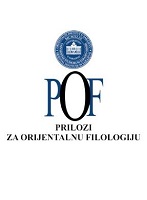Figurativna transgresija svetog prostora u sufijskoj poeziji na orijentalnim jezicima
The Figurative Transgression of The Holy Space in Sūfī Poetry in Oriental Languages
Author(s): Berin BajrićSubject(s): Literary Texts
Published by: Orijentalni Institut u Sarajevu
Keywords: Holy Text; Uššaki; semiotics of space; intertextuality; transgression; Sūfī poetry
Summary/Abstract: The intertextuality can be understood as a practice of transmitting and mixing of various semiotic spaces. The intertextuality “colonizes” the text spaces, in our cases the spaces of poetry, and more concretely Uššaki’s poetry in Arabic, with other texts and their contexts. The intertextual figures are transplanting semiotic “foreign bodies” into new textual organisms; they transmit textual spaces or their fragments into original represented space. When “foreign bodies” have been built into the literary work, they are capable of changing, doubling and expanding its spatial semantic, thus making spatial transgressions. This paper intends to discover and present the behaviour of intertexts as peculiar textual spaces carried over into poems, that is, how much they expand the semantic space of the verse. The connection of the analyzed poetry to the Qur’anic text is very interesting, which is the reason why we are trying to discover how the Qur’anic intertext as holy space acts when it is incorporated into the structure and space of a verse. We consider that these intertexts expand and enrich semantic spaces of the poems, and it makes the world of the poem more complex, and poetical images more beautiful and clearer.
Journal: Prilozi za orijentalnu filologiju
- Issue Year: 2013
- Issue No: 62
- Page Range: 29-61
- Page Count: 33
- Language: Bosnian

